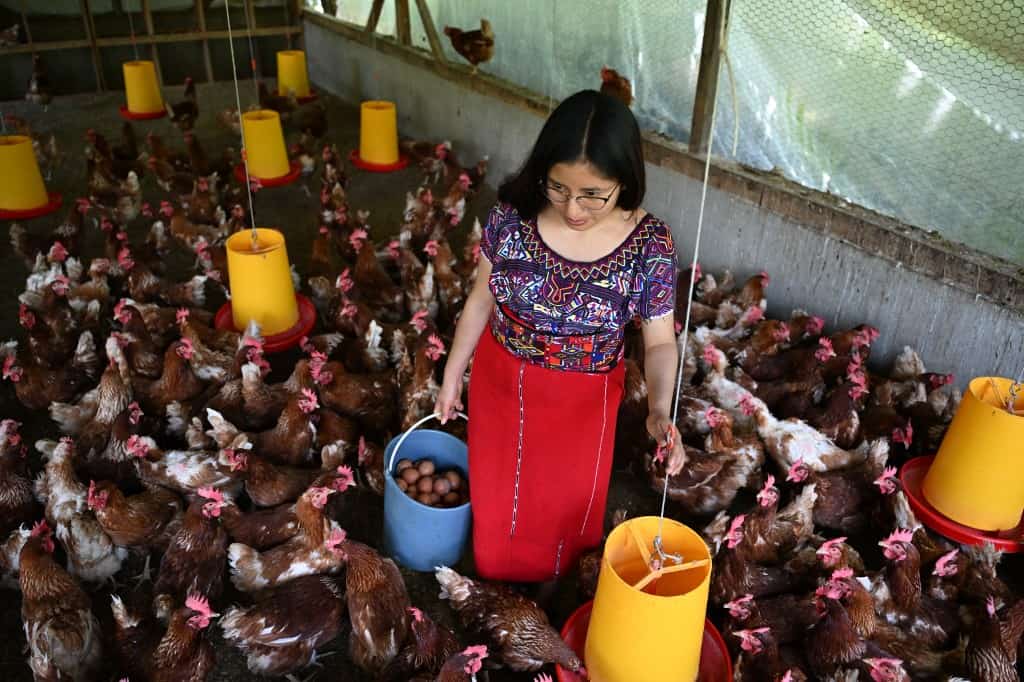The hens flutter around in the yard as Rebeca collects the eggs she will sell in her village in the indigenous north of Guatemala. It’s an enterprise she is betting on to avoid migrating to the United States, like her two brothers did, driven by poverty.
Other inhabitants of the Mayan municipality of Santa María Nebaj, in the department of Quiché, also left. However, Rebeca Pérez, a single mother, remains and supports her 8 and 11-year-old children with her poultry farm.
“Here you can generate income, not just there (in the United States). Here, there are also many opportunities,” said the 28-year-old, dressed in a multicolored indigenous outfit.
Rebeca, along with Jacinto Pérez and Edwin López, are among some 250 peasants who learn agricultural production, marketing, and commercialization techniques in seven municipalities of Quiché through a program created in 2020 by Save the Children.
The project, developed by the NGO in conjunction with the Guatemalan Ministries of Agriculture and Education, with financial support from the United States, aims to ensure food for the children of Quiché, one of the country’s poorest regions, using locally-sourced products sold to schools.
Jacinto grows tomatoes and other vegetables in Nebaj that he supplies to 10 schools. In the neighboring municipality of San Juan Cotzal, Edwin sells hens, and plants corn and beans, with improved seeds provided by the NGO.
None of the three see their future outside the country, even though poverty (affecting 59% of the 17 million inhabitants) and criminal violence drive a continuous and illegal exodus to the United States. The U.S. deported 40,713 Guatemalans in 2022, more than double than in 2021. “I better fight here,” Edwin tried in 2018 after becoming unemployed as a teacher, then 33 years old.
“Out of necessity, I took the path with the intention of reaching the U.S. Human traffickers move you in hiding, like a slave, without sleep, without food,” he said.
However, he was caught by U.S. authorities and detained for 27 days before being deported. “With all that one experiences there… personally, I lost the desire to return. It’s better to fight here,” he affirms.
It hasn’t been easy. His house was destroyed by hurricanes Eta and Iota in 2020, but he managed to build another wooden one where he lives with his wife and two children, ages 13 and four, his favorite.
There, among the hills of San Juan Cotzal, trainers from Save the Children sought him out to educate him about soil conservation, fertilizers, and even climate change.
In Nebaj, at the Field Technical School for School Feeding (ETCAE), created in 2023 as part of the program, Rebeca learned how to prevent diseases in chickens, make them lay more eggs, and promote the healthy consumption of fresh products in her village.
From Pulay, a primarily agricultural town of around 2,000 inhabitants, “many men had to migrate” in search of work. It then became evident that “we women can” be good entrepreneurs, she says, satisfied.
She started her business in 2016 with a loan from one of the two brothers who live illegally in the state of Florida. From a handful of hens, she now has 300 and aims to reach a thousand next year. “I already have a market,” she says, also proud to provide jobs for six other women in her village, as egg collectors and packers.
“Step by step towards the future,” Jacinto, also trained at ETCAE, has three employees under his charge and is associated with another 12 small producers, whom he assists with “invoice management.”
“Traveling to the U.S. is a risk. Many who go lose money, family, and even worse: their life. On the other hand, here we move forward little by little,” he maintains.
Although it was not specifically conceived to curb migration, the program has an impact on the phenomenon, according to the agricultural plan director of Save the Children, Lucrecia Méndez.
“Local producers have increased their income to meet their needs and improve the lives of their families, which has helped reduce irregular migration,” she believes. The incomes vary, but “the profit percentage ranges between 30% and 40%,” the NGO estimates.
Sitting on the porch of his wooden house, between the cornfield and the bean field, Edwin reads to his restless son Dylan, the youngest of his children, the story “Theseus in the Labyrinth.”
“I want to keep fighting close to them to watch them grow,” he emphasizes, before returning to the farm chores.






